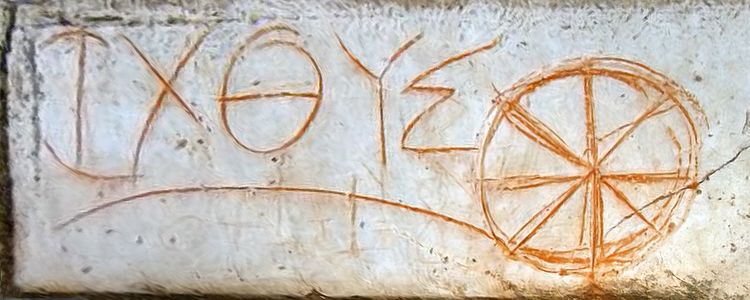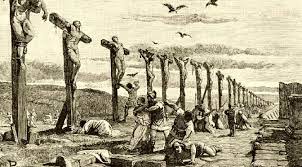
But what was the early Church's symbol of this highest love — laying down one's life for his friends? Was not this the primary message of the Risen Christ as He prepared to ascend?

This morning on St. Thomas Sunday let us consider "the Twin." Thomas' devotion to Jesus stands out in the Gospel According to John. And looking ahead we see that no Apostle exceeded Thomas in his zeal to obey Jesus, going to the ends of the earth, founding the Church in India and perhaps China. He is called the Twin by St. John precisely in this vein of devotion and zeal:
|
Then Thomas, who is called the Twin, said to his fellow disciples,
"Let us also go, that we may die with Him." (Jn 11:16) |
Where my Brother goes I will go, he says. Where my Brother dies I will die. And, of course, the story of Naomi and Ruth: "Wither thou goest I will go. And wither thou diest I also will die."
Certainly, through adoption by God the Father, each and every disciple is a brother to Jesus. But it is only through devotion and faithfulness over a lifetime that we might become Jesus, and in that sense a twin, through the process of theosis.
Certainly, no human in the New Testament makes a higher claim for Jesus' Divinity than Thomas: "My Lord and my God!" — a distinction that has not escaped the demons (Mk 3:11).
As our lesson opens, Thomas is absent. He cannot stomach the company of the others. His tone is plain enough. He is down in the streets daring the authorities to arrest and execute him while the others cower in the upper room precisely as they had cowered in Galilee. You will recall they tried to talk Jesus out of going to Jerusalem: "To Jerusalem?! We shall all die there!"
It is not doubt in Jesus that besets Thomas but rather his failure to bow before Apostolic authority You see the Apostles had all pronounced on this, but anything they had to say was of no interest to Thomas. Yet, Jesus only a few verses earlier instituted them as an Apostolic college ("He breathed on them").
But our subject this morning is "the Twin." The term occurs three times in St. John's Gospel referring each time to Thomas. The only other place in all the New Testament where is appears is the Book of Acts. So let us join St. Luke and his companions on the deck of a ship:
|
After three months we sailed in an Alexandrian ship whose figurehead was
the Twin Brothers, which had wintered at the island. And landing at Syracuse, we stayed three days. (Acts 28:11-12) |
They sailed with the twin brothers. They landed in Syracuse. They stayed three days. What? the "Twin Brothers," "Syracuse," "three days"! Was there anyone on-board who did not hear these words and feel a surge of Heavenly inspiration sweep over them .... perhaps with tears standing in their eyes? This little string of pearls, these few words: this is who they were, what they stood for. This was now the reason for their being and what they would die for. Indeed, dying for this they understood to be the essence of The Way, the "Kingdom of Heaven religion." For this brief litany summed up the beauty, the power, and the sublime goodness of what would become known later Christianity.
Well might the Twins appear on the prow of a ship. They were the universal symbol to the entire classical lifeworld of the highest good, mentioned in that "best-seller" little book of Cicero, Laelius de Amicitia. Who did not know these things?

But what was the early Church's symbol of this highest love
—
laying down one's life for his friends?
Was not this the primary message of the Risen Christ as He prepared to ascend?
| "Greater love has no one than this, than to lay down one's life for his friends." (Jn 15:13) |
Here was the community of love — "But this ye shall be known as my disciples." They followed the God Who Is Love. And following that God, they would gladly lay down their lives for Him and for each other .... and, of course, many did.
Hearing all this, we today would expect these men and woman to be wearing .... what around their necks? Why, the Cross of course! Or, if they feared persecution, they surely would have one in their pockets. Yet, no matter where you looked, you would not find a cross among any follower of The Way during the first century. You would not find one in their homes, and you would not find one in their places of gathering or worship. For during this early period, they would have been scandalized by the Cross. Indeed, St. Paul declares this revulsion plainly:
| the word (logos) of the Cross is foolishness .... (1Cor 1:18) |
ordained by God to "destroy the wisdom of men," says St. Paul. The Greek word is muría, from which we get our word moronic. The Letter to the Hebrews states it more boldly: the Cross is "despicable" and "shameful" (Heb 12:2).
For all St. Paul's efforts, however, he was not able to overcome the scandal of the Cross during his lifetime. Indeed, five centuries of distance would be required to accomplish that feat.
Needless to say, the earliest baptisms included exorcisms, yet that signature instrument of the modern exorcist, the Cross, was never used to cast out demons. By contrast, the Gospels attest devils being cast out by Jesus' Name (Mt 10:8). And St. Justin Martyr (b. 100 A.D.) writes that every demon that is exorcised is defeated and submits to the Name of Christ (First Apology, 85, 2). St. Ignatius of Antioch (Philippians 3, 12), Clement of Alexandria (Stromata 4:14), and Origen, (Against Celsus 6:44) all agree that the Name of Jesus and the power of the Word of God were efficacious. It must be the living, breathing sound of Jesus' Name or of the Word of God, the living breath, the vibrations of these syllables of power .... this is what caused demons to flee in terror. These constituted, this living, stirring life constituted, the power to cast out devils.
And this is a key: living, breathing life (as Jesus had just breathed on the Apostles) issuing from the most holy vessel of human creatures .... these were the manifestations of Divine life, not objects.
Centuries would pass before a written contract was held to have a higher dignity than the living breath exchanged between two people to form a solemn agreement. The material ink and paper was held to degrade that holy compact between two people.
During the first century, when you encountered someone who might be a disciple of Jesus, you would draw an arc in the sand — the beginning of a circle, which is the sign perfection and never-ending completeness.
How would the stranger reply? If he were a follower of Jesus, he would place a stick at the beginning of the arc but then make a mirror image, drawing in the opposite direction and then intersecting near the tail of what we would call "the fish." The resulting glyph was no static token, but rather a picture of eternity and a narrative of the Divine.
For the Greek word for fish is
IXTHYS,
presents an anagram:

Five simple letters.
That the Theta character should appear at the center
of this little group
—
ι
χ
θ
υ
ς
—
adds a deeper dimension,
stating that Jesus Christ is also "the Resurrection and the Life."
For the Theta symbol manifestly diagrams the journey of life, afterlife, and rebirth.
The top arc begins at a horizontal line, which is birth,
then
arcs upward
and
then down
to the end of that line, which is death.
Then it arcs downward to a nadir,
which is Hades,
and
finally arcs upward to the original point,
signifying new birth
of the same life.
The Greeks understood this glyph calling death
Θανατος
/
Thanatos,
abbreviated as θ.
(The Greeks believed in the afterlife.)
Thus was Theta an early symbol for infinity .... or eternity, if you like.

In God's serendipity the fish resembles another infinity symbol,
the horizontal "figure eight,"
which would not be used in mathematics until the seventeenth century.
Today,
scholars speculate that this symbol was derived from the Greek character
ω
/
omega
,
which, of course, is an identity of Jesus (Rev 22:13).
The sign of the fish. What a complex cryptogram achieved with two simple strokes! Yet it tells the story of Jesus: His life, His death, His resurrection, His salvation, His Divine identity and the eternal Kingdom He spoke of.
But be sure of this though it may trouble us: no early disciple would ever etch a cross on the ground. For they all believed it was not Jesus' death, but His Life which has saved us.
I will not go back over this subject, upon which we have reflected several times — Origen's conceit of the Emperor's Image on the coin fading into a indecipherable slug; Athanasius' conception of the defaced portrait of humanity which could not be amended for lack of a model; Irenaeus' description of Adam and Eve as impatient, reckless children bringing disaster on humankind. It would be the cosmic shock of the Creator, His Life, touching the Creation which re-stamped the coin, which restored the portrait, which completed Adam's unfinished course. It is Jesus' Life that redeemed all.

The Cross represented horrible degradation of that holiness.
It was burned into every grieving heart among the scattered Tribes of Jacob.
Only four years before the
birth of Jesus,
most horrible news reached all people in the Levant:
the Roman general Varus
rounded up two thousand Jewish men
and
crucified them in a single day.
And at the foot of each cross, he had the families of the victim
butchered in the sight of the dying man.
Could a more heinous crime be devised by the human mind?
And this all took place
(on the eve of Jesus' birth)
only
three miles from the village of Nazareth ....
affording us a glimpse into why the Crucified One
would be called a Nazarene.
For our God is with us.
From that moment the Cross became the most hateful image in the Jewish imagination.
This horrible news spread throughout the Levant — a narrative no one could bear to hear more than once. But be sure of this: everyone heard it. No. The Cross was not cherished any more than the ovens of Auschwitz would be a triumphant symbol to Jewry today. As I said, five centuries would have to pass before the Cross would be received by the Church, adorning believers and prominently display in church buildings.
To us today, the Cross is life-giving and wonder-working. And these properties were tirelessly advertised by dramatic stories and legends, such as the ones associated with St. Helena's discover of the true cross and its power to raise the dead.
Certainly, I do not minimize the Cross. I am a priest of God. I wear a Crucifix under my clothing. I wear a Crucifix over my clothing. I give thanks for its life-giving and wonder-working properties and holy protection. But for me, its greatest eloquence, its most trenchant word, was a revelation to the unbeliever of something the believer already knew: Jesus was, and is, the Son of the Living God, the Lord of all Life, and with ease the victor over death. Death is not a thing. It is a moment, a meaningless moment in the eyes of God. Jesus was, and is, the Savior of the world before all worlds.
As an Orthodox priest, my preoccupation has become the original faith. My constant meditation is the Lord Jesus as He actually was, His many disciples, the lifeworld in which they lived, and the Church as it was born and developed during these first decades and centuries .... such that we can know these things. This is my passion.
The Hermitage offered an extended study during Great Lent meditating on two lifeworlds: the Hebrew faith of the Northern Kingdom associated with the First Temple and the recent hybrid religion, Judah-ism, associated with the Southern Kingdom and the Second Temple. But, of course, both these historical kingdoms were surrounded by a Hellenized lifeworld whose common language was Greek, which Jesus and the His Disciples spoke. Their Bible was the Septuagint, not the Hebrew Scriptures, which was so closely tied to the Second Temple and to Pharisaism.
The primary symbol of the The Way instituted by Jesus was not an object, but rather lives lived. I would go so far as to say that no two lives in the classical lifeworld were more prominent in laying down one's life for his friends than Damon and Pythias. Their story was celebrated throughout the first century from Britain to Arabia. Their story spoke powerfully into the hearts of believers and would-be believers.
To understand how a story involving two Greek friends visiting Syracuse could convey such strong feelings we must understand that in the ancient lifeworld, the highest good was seen into two men loving virtue who loved each other with the highest love and who lay down their lives for each other. When Jesus says "Greater life hath no one ...." all who heard Him would fill in the blank: the Greek word agape, which equated to Cicero's word amicitia. This was the greatest love and the highest good — the highest and most noble state of the human person. Aristotle, writing centuries earlier, had already declared this: the pure love shared between two men loving the highest virtue is the highest of all goods.
Here was the narrative that captured the drama on Golgotha hill. The innocent Jesus was arrested, beaten, and stood trial, but the guilty party was ourselves. And what was our crime? It was the crime we encounter in Eden, the crime committed by the Prodigal Son, the crime committed by a new, rapidly-spreading hybrid religion, introducing Babylonia rites into the God's Temple. Did we not see a precedent which played out before God's Tabernacle, at the foot of Mount Sinai, even as God was revealing His Holy Will and Mind upon its summit? .... pagan worship insolently carried out in the face of the Almighty! In a word, the crime was disobedience, willfulness, we do not have to stretch to see that this is what separates from God today. This is our eternal crime, which equates to alienation from God, whose locus is Hell.
Jesus preached the high importance of unity with God. He faithfully stood in our place, like Damon, waiting for the arrival of His justly accused friends. He was the ransom for many (Mk 10:45, Mt 20:28), and He waited. He waited for His faithful friends.
We may ask, how could Jesus' followers have been faithful as Pythias was to Damon? It might have taken many forms. The Twelve could have stood with Him rallying the fickle crowd to support them. The Seventy (actually there were many more than that) could have surrounded Him. The crowd, thus being led, could have cried out for his liberation before Pilate shouting down the Jews. But none of these things happened. As Jesus looked out on a horizon suspended high on a hill ..... He saw no one coming.
For Jesus was the Damon Who trusted His friends .... that proved not to be His friends. He awaited His noble friends, loving the highest good. But He waited in vain. These are the values of the "Kingdom of Heaven religion."
On the other side, the Jews, who were inured to sacrifice as the way to appease god, schemed to offer Jesus as a sacrifice to appease the Romans.
|
Now it was Caiaphas who advised the Jews that it was expedient
that one man should die for the people. (Jn 18:14) |
But this, of course, was a lie, for the Romans had no heart to execute Jesus:
|
Pilate then went out again, and said to them, "Behold, I am bringing Him
out to you, that you may know that I find no fault in Him." (Jn 19:4) |
Lies, treachery, a dust cloud of confusion, and most all betrayal of one's friends. Did He not say that His betrayer would dip His bread into the dish (Mt 26:23)? I ask you, Sisters, which one dipped his bread into the dish? They all did.
Nonetheless, The Way is still open to us by the grace of God .... just as it was open to St. Luke's shipmates. We too may sail under the banner of the "Twin Brothers." We also may be faithful: faithful to God, faithful to those who love God, and faithful to our common journey that each of us might become more and more like Him, which is to say, a twin.
Sail on, my brothers and sisters!
Sail on.
For nothing less that the angels of Heaven
and
the God they serve are looking on with anticipation!
In the Name of the Father and of the Son and of the Holy Ghost. Amen.